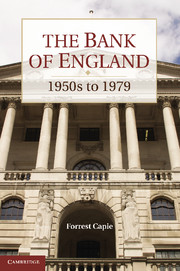Book contents
- Frontmatter
- Contents
- List of Illustrations
- List of Figures
- List of Tables
- Foreword by Mervyn King
- Preface
- Acknowledgements
- Abbreviations and Acronyms
- 1 Introduction and Overview
- 2 The Bank in the 1950s
- 3 The Monetary Setting and the Bank
- 4 The Bank's External Responsibilities to 1964
- 5 From Crisis to ‘Crucifixion’
- 6 Domestic Monetary Policy after Radcliffe
- 7 Other Activities and Performance
- 8 Sterling from Devaluation to Smithsonian
- 9 The Road to Competition and Credit Control
- 10 Competition and Credit Control
- 11 The Secondary Banking Crisis
- 12 Banking Supervision
- 13 Monetary Targets and Monetary Control
- 14 The Bank and Sterling in the 1970s
- 15 The Bank's Freedom to Operate
- 16 Epilogue
- Bibliography
- Index
- Titles in the series
6 - Domestic Monetary Policy after Radcliffe
Published online by Cambridge University Press: 05 July 2011
- Frontmatter
- Contents
- List of Illustrations
- List of Figures
- List of Tables
- Foreword by Mervyn King
- Preface
- Acknowledgements
- Abbreviations and Acronyms
- 1 Introduction and Overview
- 2 The Bank in the 1950s
- 3 The Monetary Setting and the Bank
- 4 The Bank's External Responsibilities to 1964
- 5 From Crisis to ‘Crucifixion’
- 6 Domestic Monetary Policy after Radcliffe
- 7 Other Activities and Performance
- 8 Sterling from Devaluation to Smithsonian
- 9 The Road to Competition and Credit Control
- 10 Competition and Credit Control
- 11 The Secondary Banking Crisis
- 12 Banking Supervision
- 13 Monetary Targets and Monetary Control
- 14 The Bank and Sterling in the 1970s
- 15 The Bank's Freedom to Operate
- 16 Epilogue
- Bibliography
- Index
- Titles in the series
Summary
The Bank's main policy goal in the 1960s was to maintain the exchange-rate parity. Apart from this, a prime function was to ensure the smooth financing of the exchequer, and of lesser importance was the control of bank advances. To these ends, the Bank pursued order (nowhere defined) in the money and gilts markets. As Radcliffe saw it, debt management and funding were central in monetary policy. The containment of inflation was seldom explicit, but concern was frequently expressed over the expansion of credit or the growth of bank advances. However, it should be stressed that monetary policy at the time was neither remotely like that of previous periods nor of later ones, nor did it bear much resemblance to what was found in textbooks. The monetary authorities, especially the Treasury, had for some time been uncertain as to the effectiveness of conventional monetary policy for controlling the domestic economy. The views found in the Radcliffe Report were not far from those of the Treasury, and it was these kinds of ideas that gave rise to the enquiry in the first instance. That is, it was the reading of the experience of the years 1955–57 in particular that suggested that monetary policy did not deliver or certainly not quickly. Thus monetary policy became instead a collection of devices intended to work on both the domestic and external variables: ‘It was neither aimed at controlling the stock of money nor was it much relied upon to combat inflation.
- Type
- Chapter
- Information
- The Bank of England1950s to 1979, pp. 252 - 317Publisher: Cambridge University PressPrint publication year: 2010



